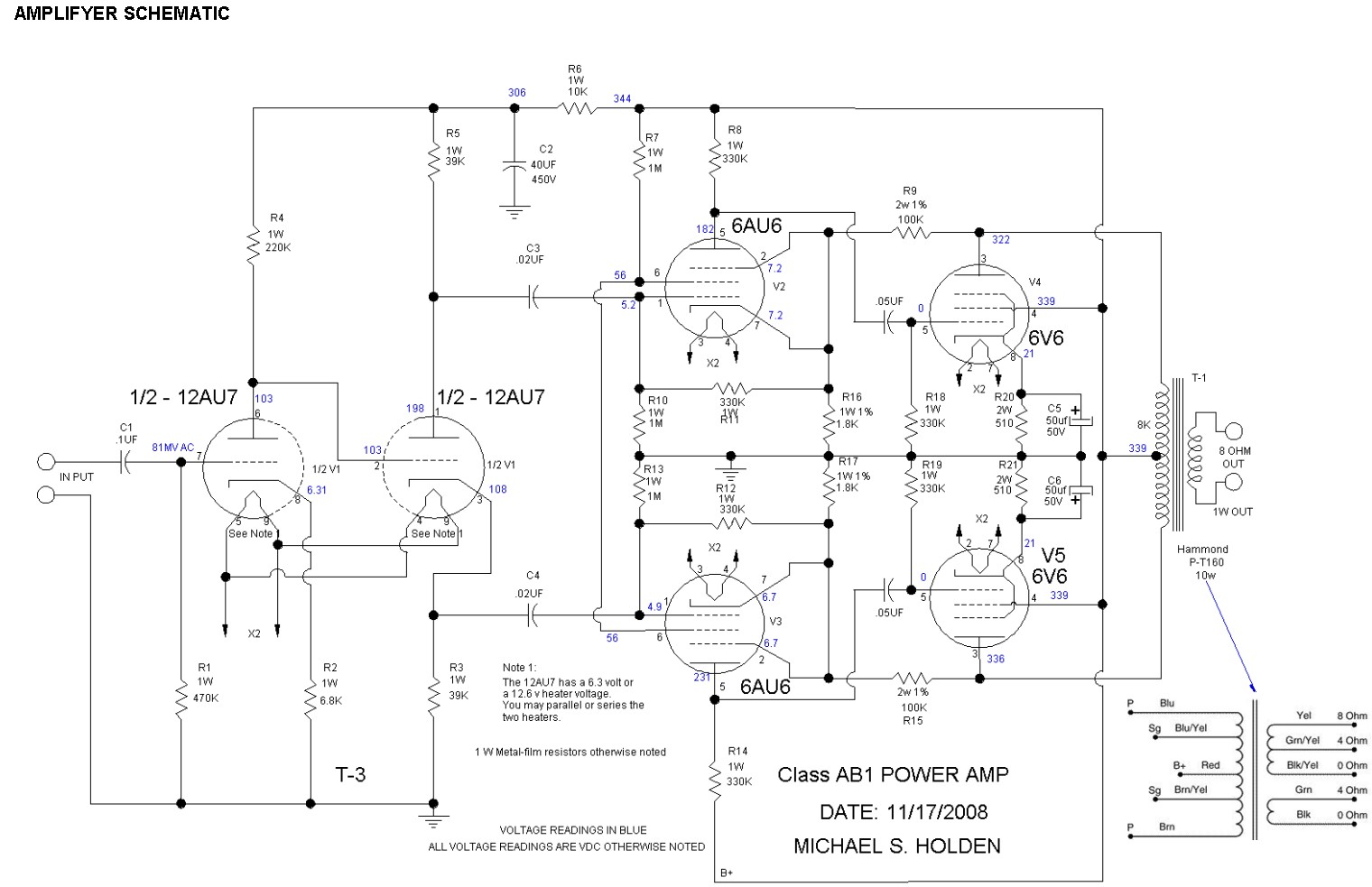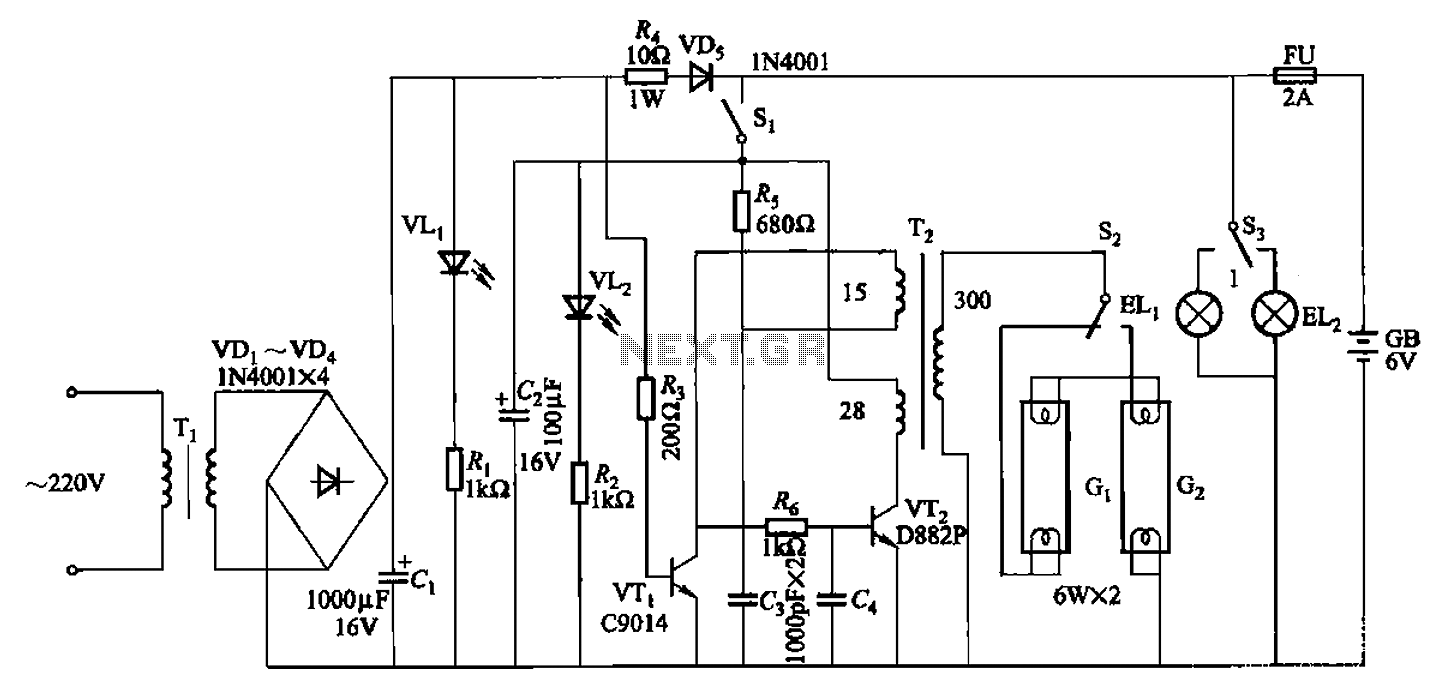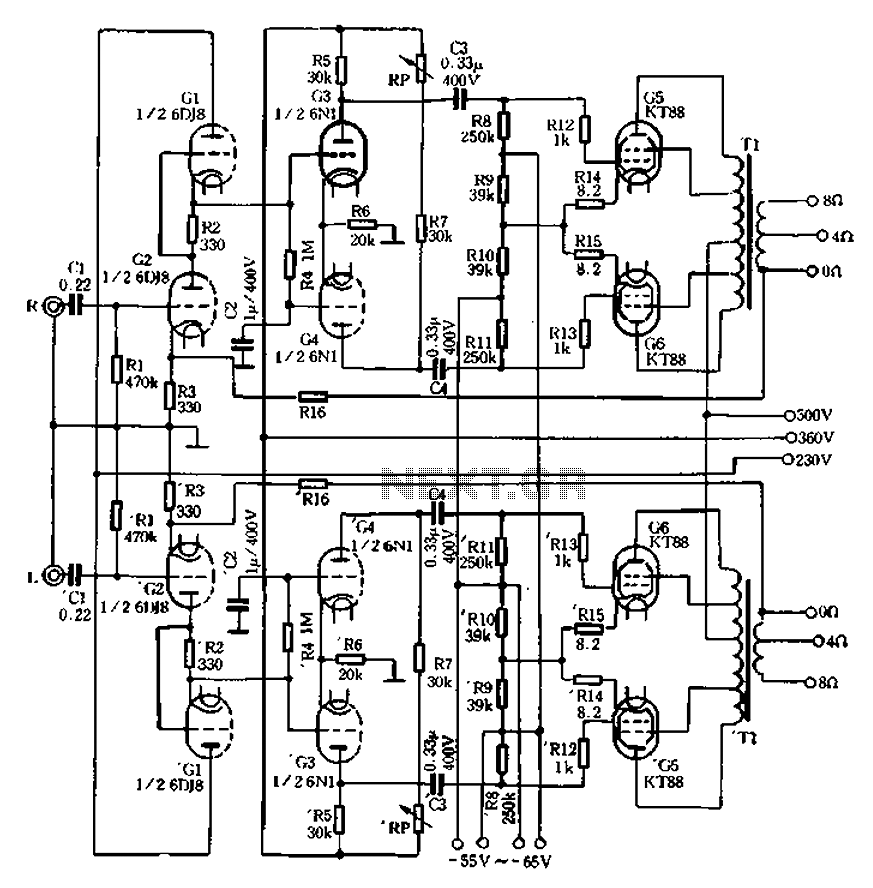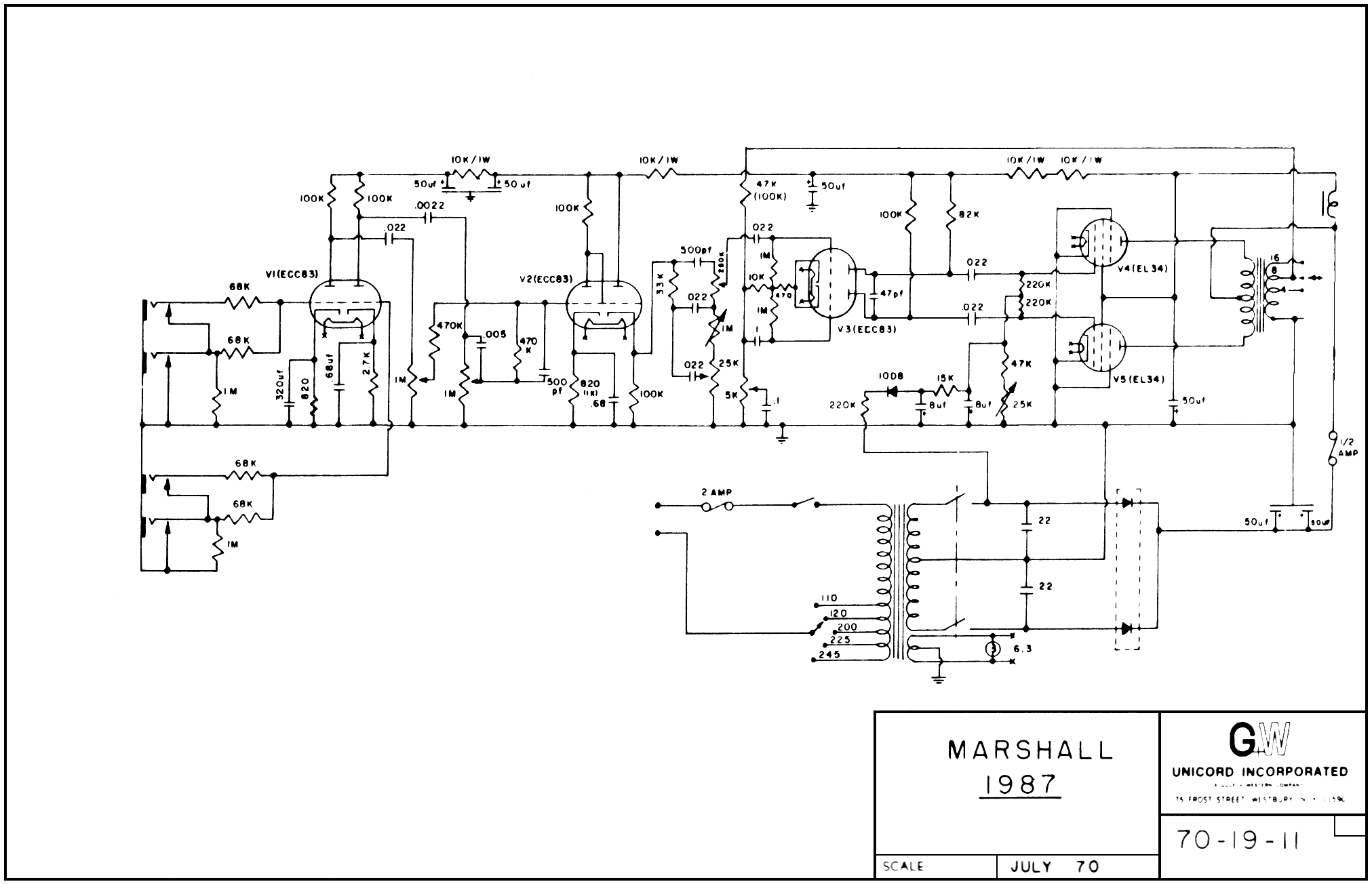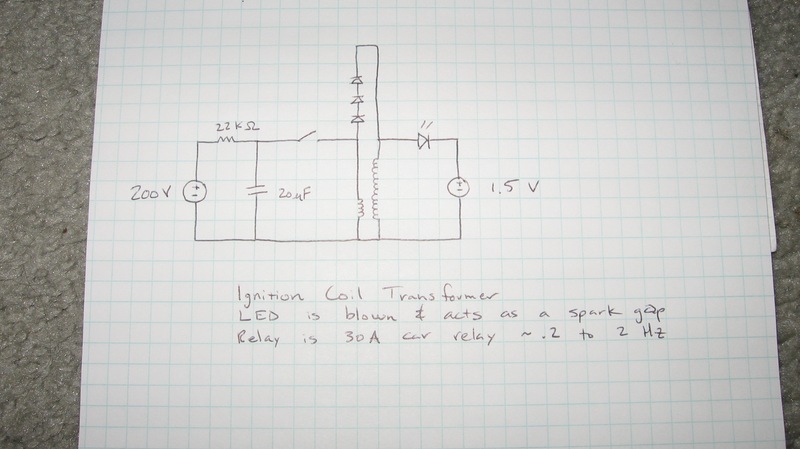
tube overdrive pedal
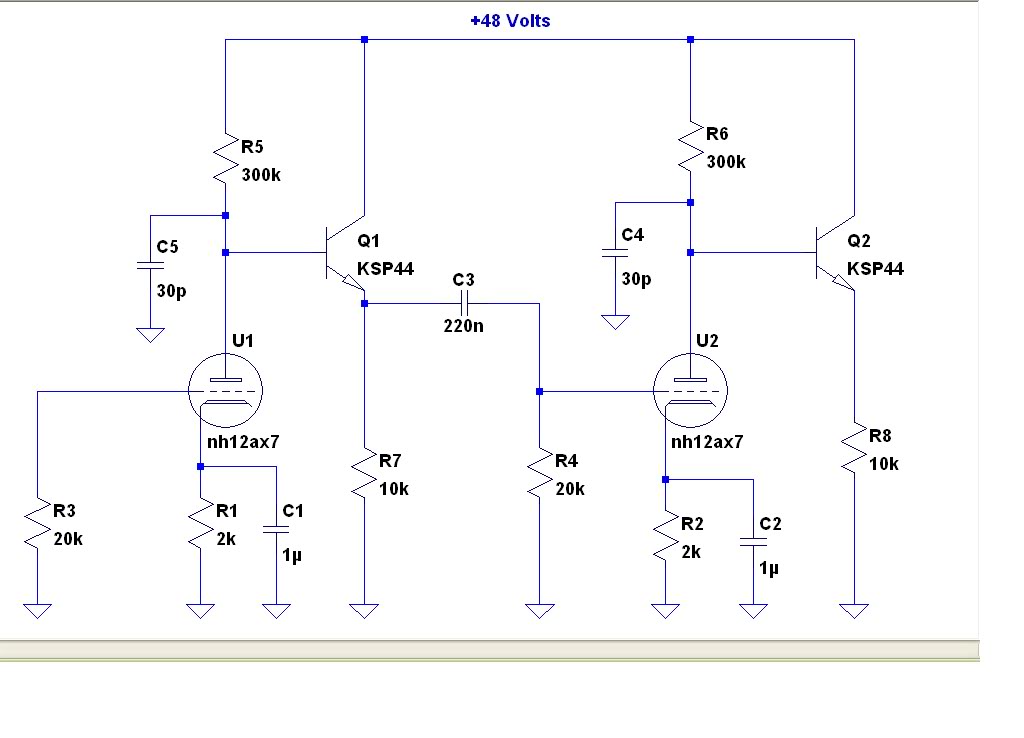
The circuit is conceptually similar to the BK Butler/Tubeworks Tube Driver. Operating on a 9V supply, the tubes function in "starved plate" mode, as preamp tubes typically require 100V-300V. This situation is akin to utilizing a Variac on a tube amplifier; with only 9V supplied to the anode, the tube operates well outside its linear amplification range, making it easier to achieve distortion.
Additional details include various guitars such as the 2005 Gibson Custom Historic Series '59 Reissue (R9), the 2012 Fender American Standard Stratocaster, and the 2008 Heritage H-555 Semi-hollowbody, among others. Amplifiers and cabinets mentioned are the Mesa Boogie Express 5:25 10" combo, an ultra-modded Fender Blues Junior, and the Vox AC15 Heritage handwired 1x12 combo, along with several kit amplifiers and homebuilt units. The interest in this circuit is partly due to the ease of construction and the desire to enhance the sound of a solid-state Peavey amplifier, which lacks a genuine "tube sound." A previous experiment with an Ibanez Tube King pedal, which contains a 12AX7 tube, revealed a significant improvement in sound when connected to the preamp.
The inquiry revolves around the possibility of designing a pedal with two or more tubes to be used in the preamp stage, despite the lack of prior experience in pedal construction. Observations indicate that the tube in the current circuit may serve merely a decorative role, with the battery only powering an LED. Analysis of the circuit shows that the heater pins (4 and 5) are the only ones passing the signal, suggesting that the heater element functions as an inductor in the signal path. However, without current supplied to the heater, there is no space charge of electrons within the tube, raising questions about its operational efficacy. For low-voltage tube overdrive applications, it is noted that tubes designed for car radios, which operate on a 12V supply, were previously available.
The described circuit utilizes a 9V power supply to operate vacuum tubes in a manner that deviates from traditional high-voltage configurations. This "starved plate" operation allows for unique audio characteristics, particularly in achieving distortion, which is a desirable quality for electric guitar applications. The circuit's design can be adapted to accommodate multiple tubes, potentially enhancing the sonic quality and versatility of the output.
In constructing such a circuit, considerations must be made regarding the choice of tubes, as well as the specific configurations of the heater and anode voltages. The integration of a tube within a pedal format would require careful design to ensure that the tube operates effectively within its intended range, even under low-voltage conditions. Additionally, the use of specialized low-voltage tubes, such as those developed for automotive applications, could facilitate the creation of a more robust and responsive overdrive pedal.
The final design may also incorporate features such as tone control and gain adjustment to further refine the output sound. The overall goal would be to replicate the warmth and dynamic response associated with traditional tube amplifiers while maintaining the practicality and convenience of a pedal format for use with solid-state amplifiers.That circuit is similar in concept to the BK Butler/Tubeworks Tube Driver. Since there is only a 9v supply, the tubes operate in "starved plate" mode. Preamp tubes normally operate on 100v-300v. It`s similar to using a Variac on a tube amp. When there is only 9v on the anode the tube operates way outside its linear amplification range and is easy to push into distortion. Guitars - `05 Gibson Custom Historic Series `59 Reissue (R9); `12 Fender American Standard Stratocaster; `08 Heritage H-555 Semi-hollowbody; `06 Carvin CT6M California Carved Top; `89 Fender Strat Plus; `10 Agile AL-3000; `12 G&L Tribute ASAT Classic Bluesboy Semi-hollowbody; " Kwik-Keef Konvertible " `09 Squier CV `50s Telecaster; `10 Squier CV Telecaster Custom; `12 Squier Vintage Modified Cabronita Tele + Bigsby; `12 Xaviere XV-890HSS w/ FR Trem; `12 Epiphone Masterbilt DR-500MCE; `71 Yamaha FG-300 Amps & Cabs - Mesa Boogie Express 5:25 10" combo; ultra-modded Fender Blues Junior; Vox AC15 Heritage handwired 1x12 combo; Allen Sweet Spot kit amp ; BYOC Tweed Royal kit amp (switchable 5E3/5F1 hybrid); Trinity 18W kit amp ; Homebuilt 1. 5W Firefly Head ; Epiphone Valve Jr. combo + mods ; Jet City Picovalve 5W head; Drive 2x12 cab w/ Celestion G12M Greenback + G12H30; AB Custom Audio 1x12 cab w/ Celestion Alnico Blue (UK made) what made it interesting to me (other then it doesnt look to hard to build), is i use a solid state xxl peavey amp, and it allows you to put something in the preamp (pedals etc).
while the amp is a real good SS amp, it has no real "tube sound", so one day i took my ibanez tube king pedal (has a 12ax7 tube) and plugged it in the preamp and maaaannnn was i suprised at how it sounded, like a totally different amp. So anyway i was wondering if there was a way to make this pedal with 2 or 3 or more tubes in it, as i could run it in the preamp, but ive never attempted making a pedal before.
any idea The tube in the circuit looks to be for decorative purposes only and all the battery does is light the LED. I drew the circuit out and the only pins on the tube doing anything are the heater pins 4 and 5 passing the signal.
So at best the heater element is being used as an inductor in the signal path. There is no current supplied to the heater so no space charge of electrons in the tube so how could the tube work If you want to make a tube overdrive with low voltages they used to make tubes for car radios that work with a 12 volt supply. I h 🔗 External reference
Additional details include various guitars such as the 2005 Gibson Custom Historic Series '59 Reissue (R9), the 2012 Fender American Standard Stratocaster, and the 2008 Heritage H-555 Semi-hollowbody, among others. Amplifiers and cabinets mentioned are the Mesa Boogie Express 5:25 10" combo, an ultra-modded Fender Blues Junior, and the Vox AC15 Heritage handwired 1x12 combo, along with several kit amplifiers and homebuilt units. The interest in this circuit is partly due to the ease of construction and the desire to enhance the sound of a solid-state Peavey amplifier, which lacks a genuine "tube sound." A previous experiment with an Ibanez Tube King pedal, which contains a 12AX7 tube, revealed a significant improvement in sound when connected to the preamp.
The inquiry revolves around the possibility of designing a pedal with two or more tubes to be used in the preamp stage, despite the lack of prior experience in pedal construction. Observations indicate that the tube in the current circuit may serve merely a decorative role, with the battery only powering an LED. Analysis of the circuit shows that the heater pins (4 and 5) are the only ones passing the signal, suggesting that the heater element functions as an inductor in the signal path. However, without current supplied to the heater, there is no space charge of electrons within the tube, raising questions about its operational efficacy. For low-voltage tube overdrive applications, it is noted that tubes designed for car radios, which operate on a 12V supply, were previously available.
The described circuit utilizes a 9V power supply to operate vacuum tubes in a manner that deviates from traditional high-voltage configurations. This "starved plate" operation allows for unique audio characteristics, particularly in achieving distortion, which is a desirable quality for electric guitar applications. The circuit's design can be adapted to accommodate multiple tubes, potentially enhancing the sonic quality and versatility of the output.
In constructing such a circuit, considerations must be made regarding the choice of tubes, as well as the specific configurations of the heater and anode voltages. The integration of a tube within a pedal format would require careful design to ensure that the tube operates effectively within its intended range, even under low-voltage conditions. Additionally, the use of specialized low-voltage tubes, such as those developed for automotive applications, could facilitate the creation of a more robust and responsive overdrive pedal.
The final design may also incorporate features such as tone control and gain adjustment to further refine the output sound. The overall goal would be to replicate the warmth and dynamic response associated with traditional tube amplifiers while maintaining the practicality and convenience of a pedal format for use with solid-state amplifiers.That circuit is similar in concept to the BK Butler/Tubeworks Tube Driver. Since there is only a 9v supply, the tubes operate in "starved plate" mode. Preamp tubes normally operate on 100v-300v. It`s similar to using a Variac on a tube amp. When there is only 9v on the anode the tube operates way outside its linear amplification range and is easy to push into distortion. Guitars - `05 Gibson Custom Historic Series `59 Reissue (R9); `12 Fender American Standard Stratocaster; `08 Heritage H-555 Semi-hollowbody; `06 Carvin CT6M California Carved Top; `89 Fender Strat Plus; `10 Agile AL-3000; `12 G&L Tribute ASAT Classic Bluesboy Semi-hollowbody; " Kwik-Keef Konvertible " `09 Squier CV `50s Telecaster; `10 Squier CV Telecaster Custom; `12 Squier Vintage Modified Cabronita Tele + Bigsby; `12 Xaviere XV-890HSS w/ FR Trem; `12 Epiphone Masterbilt DR-500MCE; `71 Yamaha FG-300 Amps & Cabs - Mesa Boogie Express 5:25 10" combo; ultra-modded Fender Blues Junior; Vox AC15 Heritage handwired 1x12 combo; Allen Sweet Spot kit amp ; BYOC Tweed Royal kit amp (switchable 5E3/5F1 hybrid); Trinity 18W kit amp ; Homebuilt 1. 5W Firefly Head ; Epiphone Valve Jr. combo + mods ; Jet City Picovalve 5W head; Drive 2x12 cab w/ Celestion G12M Greenback + G12H30; AB Custom Audio 1x12 cab w/ Celestion Alnico Blue (UK made) what made it interesting to me (other then it doesnt look to hard to build), is i use a solid state xxl peavey amp, and it allows you to put something in the preamp (pedals etc).
while the amp is a real good SS amp, it has no real "tube sound", so one day i took my ibanez tube king pedal (has a 12ax7 tube) and plugged it in the preamp and maaaannnn was i suprised at how it sounded, like a totally different amp. So anyway i was wondering if there was a way to make this pedal with 2 or 3 or more tubes in it, as i could run it in the preamp, but ive never attempted making a pedal before.
any idea The tube in the circuit looks to be for decorative purposes only and all the battery does is light the LED. I drew the circuit out and the only pins on the tube doing anything are the heater pins 4 and 5 passing the signal.
So at best the heater element is being used as an inductor in the signal path. There is no current supplied to the heater so no space charge of electrons in the tube so how could the tube work If you want to make a tube overdrive with low voltages they used to make tubes for car radios that work with a 12 volt supply. I h 🔗 External reference
